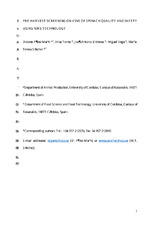Pre-harvest screening on-vine of spinach quality and safety using NIRS technology
Autor
Pérez-Marín, D.C.
Torres, Irina
Entrenas, José A.
Vega-Castellote, Miguel
Sánchez, María-Teresa
Editor
ElsevierFecha
2019Materia
SpinachSafety
Quality
Portable NIRS
In-situ analysis
METS:
Mostrar el registro METSPREMIS:
Mostrar el registro PREMISMetadatos
Mostrar el registro completo del ítemResumen
The study sought to perform a non-destructive and in-situ quality evaluation of spinach plants using near infrared (NIR) spectroscopy in order to establish its suitability for different uses once harvested. Modified partial least square (MPLS) regression models using NIR spectra of intact spinach leaves were developed for nitrate, ascorbic acid and soluble solid contents. The residual predictive deviation (RPD) values were 1.29, 1.21 and 2.54 for nitrate, ascorbic acid and soluble solid contents, respectively. Later, this predictive capacity increased for nitrate content (RPDcv = 1.63) when new models were developed, taking into account the influence on the robustness of the model exercised by the simultaneity between the NIR and laboratory analyses. Subsequently, using partial least squares discriminant analysis (PLS-DA), the ability of NIRS technology to classify spinach as a function of nitrate content was tested. PLS-DA yielded percentages of correctly classified samples ranging from 73.08–76.92% for the class ‘spinach able to be used fresh’ to 85.71–73.08% for the class ‘preserved, deep-frozen or frozen spinach, both for unbalanced and balanced models respectively, based on NH signal associated with proteins. Overall, the data supports the capability of NIR spectroscopy to establish the final destination of the production of spinach analysed on the plant, as a screening tool for important safety and quality parameters.

